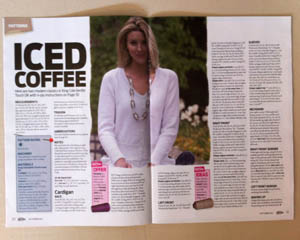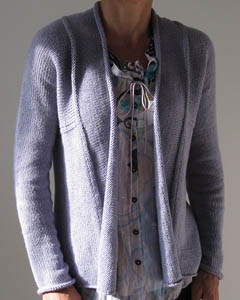So, as I said before, I had lots of false starts before I found a project to do on the knitting machine. The following might be useful to knitters, so I’ll go into detail. Non-knitters may want to skip this post.
When I reorganised my stash by allocating most of the yarn previously for hand knitting to either weaving or machine knitting, most of it went into the weaving pile. Only seven batches of yarn were set aside for five machine knitting projects.
1. Legacy Lane 5ply Alpaca Merino – already machine knit into a unfinished project
2. Black Panda Woolbale and some olive and black handspun – a vest
3. John Q Cotton Crepe – a cardigan
4. Green-blue dyed Cleckheaton Country – was Summer Solstice but now considering Career Tracks
5. Black Bendy Luxury and Te Awa Wools Hunky Hank – a stripy jumper/cardy
Before we went to New Zealand I’d read through the Bond Sweater Machine manuel again to make sure I remembered right how it worked. Then I read through the patterns in the back and realised the machine could do things I hadn’t realised it could do. The pattern for the pullover was pretty frumpy – as a lot of machine knitting patterns are – so I wasn’t tempted to use it.
I figured I ought to start with something basic and easy. I’d bought a copy of Machine Knitting Monthly and there was a simple cardigan marked ‘easy’ in there that the John Q cotton would suit.
But when I went to try it, the instructions were full of references to tools and methods I’d never heard of. At least I got some gauge swatches done.
So I considered just using the instructions in the Bond manuel but adding waist shaping, and looked through The Knitter’s Handy Book of Sweater Patterns and One Thousand Sweaters – books that have basic patterns that can be adjusted. Nothing inspired me.
The next day I started drafting up a pattern for one of those rectangular jackets with two slits in the body for the sleeves – like this one. It’s a very simple idea and best done with a yarn that’ll make a fabric with drape.
As I was doing the math, I got to thinking about sideways knit garments and how the knitting machine might be wide enough that I can do the entire body on it in one go, instead of pieces that have to be sewn together later. Like the last project I’d been working on: Summer Solstice.
And I got to thinking about Summer Solstice and how I’d started it and abandoned it twice already, the first time because the yarn was unsuitable, the second because of RSI. I remembered how annoying it was to knit because the increase and decrease rows for the front and back of the yoke didn’t match up, making it like knitting two different garments at once. Which would be even more annoying on the machine. But did it have to be so?
I got out some graph paper and began mapping out the pattern and soon my suspicions were confirmed: there really was no good reason for the pattern to be that complicated. It was possible to move the increases and decreases so they happened on the same rows without changing the shape of the garment. So I prepped the machine and got to work.
One of the limitations of knitting machines is that when you put an increase or decrease in you have to move the stitches next to it across. The yoke and arm piece of Summer Solstice, knitted sideways from the back over the shoulder to the front, has rows of decreases down the shoulder and sleeves – the middle of the work – so for every row of shaping I have to shift the stitches left or right, one at a time.
It’s time-consuming and fiddly, but worth it. Most machine knitting patterns are boxy and frumpy because it’s quicker and easier to make garments with drop shoulders and no waist shaping. But I’m not in a hurry, I’m just trying to stop overusing my hands. It used to take me a month to six weeks to hand knit a jumper or cardigan, after all.
I suspect this hand-knit pattern adaption is what most machine knitters do, anyway. Which may be why Ravelry has no ‘machine knitting’ filter in the advanced pattern search page. With weaving and crochet I tend to have trouble following patterns and do better if I just ‘wing it’, and machine knitting may turn out to be the same.




